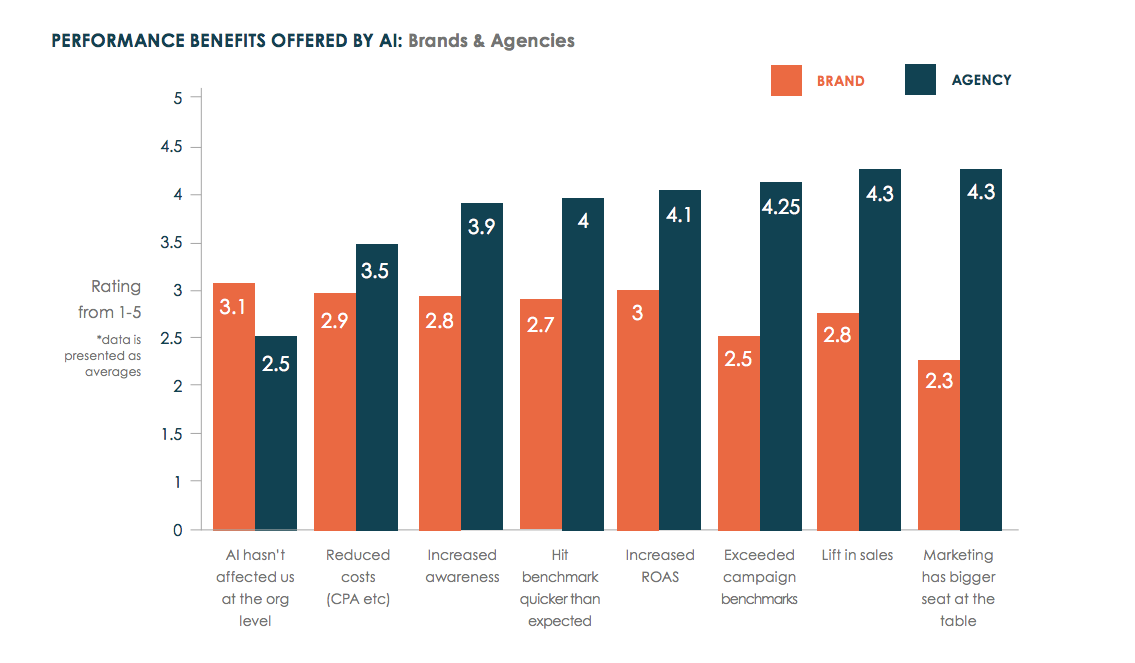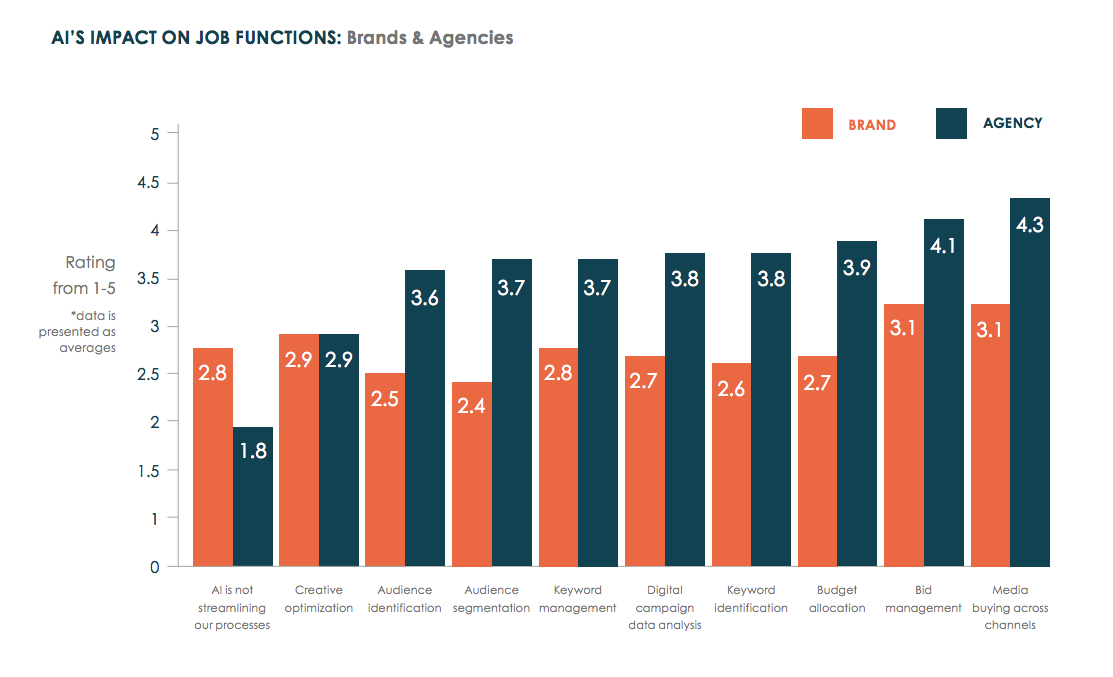Exactly one year after releasing its third-party study, AI: The Next Generation of Marketing, which gauged marketers’ early perceptions of artificial intelligence in marketing, digital autonomous marketing firm Albert Technologies has released the findings of its customer experience study, AI Adoption in Marketing: 2018 Brand & Agency Survey.
The firm set out to determine the nuances in mindset between two distinct AI user types—brand and agency marketers. The 11-question survey sought to compare where each stood on a variety of topics, such as the performance and efficiency benefits that are most important to each, which tasks they’ve found most difficult to give up to a machine, and their upfront reasons for resistance, if any.
Survey respondents were asked about AI marketing tools in general, as well as specifically about their experiences with Albert.
Key findings from the study include:
Agencies and brands are united on their initial reasoning for AI adoption
Seven out of 10 respondents cited “increasing the value of their marketing investment” as their motivation for engaging their first artificial intelligence marketing platform. This number represents 83 percent of brands and 58 percent of agencies. An additional 33 percent of agencies made the move to AI when they saw their current manual and/or technology-aided efforts plateau. Peer pressure and the desire to try the hottest new thing were less likely to influence either respondent type’s decision-making.
Agencies most value sales-related outcomes, while brands prioritize cost containment benefits
Asked to rate the performance benefits of AI, agencies gravitated toward those yielding the best results for their clients, ranking AI’s “ability to lift sales” and “exceed campaign benchmarks” equally important (both at 4.3 out of 5). While brands also appreciate revenue-based benefits, the aspects they prized most were related to cost containment, specifically “increased Return on Ad Spend” (3 out of 5) and “reduced costs” (2.9 out of 5).
Brands specifically value efficiencies that free up their time for creative or higher-level strategic activities
Brand respondents that directly manage their own AI systems focused on the ability to slough off mundane tasks to a machine and free up time among their employees for creative or higher-level strategic activities, ranking “less focus on manual” 3.2 out of 5 and “more focus on creative and strategy” at 3.3 out of 5.
Agencies are more likely to apply AI insights across siloes and campaign-wide
Brands were less likely than agencies to use insights generated from AI to inform other parts of their campaigns (agencies: 3.7 / 5.0; brands: 2.6 / 5.0), or as a means of bringing cohesion to siloed marketing efforts (agencies: 3.8 / 5.0; brands: 2.8 / 5.0).
Brands and agencies both admitted to upfront resistance to AI in response to fears they wouldn’t be able to communicate with it
Sixty-three percent of agency respondents cited an “inability to communicate with AI” as a perceived upfront drawback while 32 percent of brand respondents cited the same.
Brands claim new understanding of creative fatigue. Agencies claim new insights on new audiences
When asked which AI insights were most surprising, 33 percent of brands claimed they were most surprised by how quickly creative assets fatigue during campaigns (compared to only 8 percent of agencies). Meanwhile, 58 percent of agencies rated the “ability to discover new audiences” as particularly insightful (compared to 17 percent of brands who reported the same).
Artificial Intelligence is helping brands and agencies transcend siloes
Thirty-three percent of respondents are using AI across three marketing channels. Both brands and agencies are using their AI platforms across up to four digital channels (paid social media, search, display advertising and email), though a majority of brand and agency respondents (exactly 33 percent for each segment) reported using AI to automate digital marketing across three digital channels at once: search, display advertising and paid social media.
Brands find digital campaign data analysis the hardest task to give up to AI
Among all the tasks newly automated by their AI platform(s), 59 percent of brand respondents cited digital campaign data analysis as most difficult to let go, perhaps revealing brands’ attachment to deciphering the aha! moments (despite the hours of labor required to find them).
Agencies rate audience segmentation as the most difficult task to surrender to AI
Of all tasks that agencies have relinquished to AI, 33 percent of agency respondents agree that audience segmentation is the hardest to let go. This might be due to having become accustomed to the difficult task of pairing the right promotions with what they determine to be the right audience.
“Before we conducted our research we knew that the speed of adoption by brand-side marketers was relatively faster than the agencies that perform digital campaign execution on their behalf,” said Or Shani, CEO of Albert, in a news release. “As we’ve begun working directly with agencies, we’re discovering the nuances in how they think about and experience AI.
For instance, agencies are more likely than brands to use AI to transcend data siloes across channels and apply digital insights throughout a larger campaign. Brands, on the other hand, gravitate toward immediately actionable insights, such as the quick rate of creative fatigue among consumers. We’ve seen brands translate this particular insight into the production of more frequent creative, which allows them to seamlessly continue the narrative with consumers.”
Download the full report here.
The company conducted the blind survey in late 2017, gathering information from 52 respondents, including 17 agencies and 35 brand-side marketers. Slightly more than one quarter of respondents came from the retail and apparel sector, while media and entertainment, travel and leisure, and consumer packaged goods made up seven percent each. The last 20 percent were drawn from the consumer technology, pharmaceuticals and healthcare, transportation, and “other” categories.










